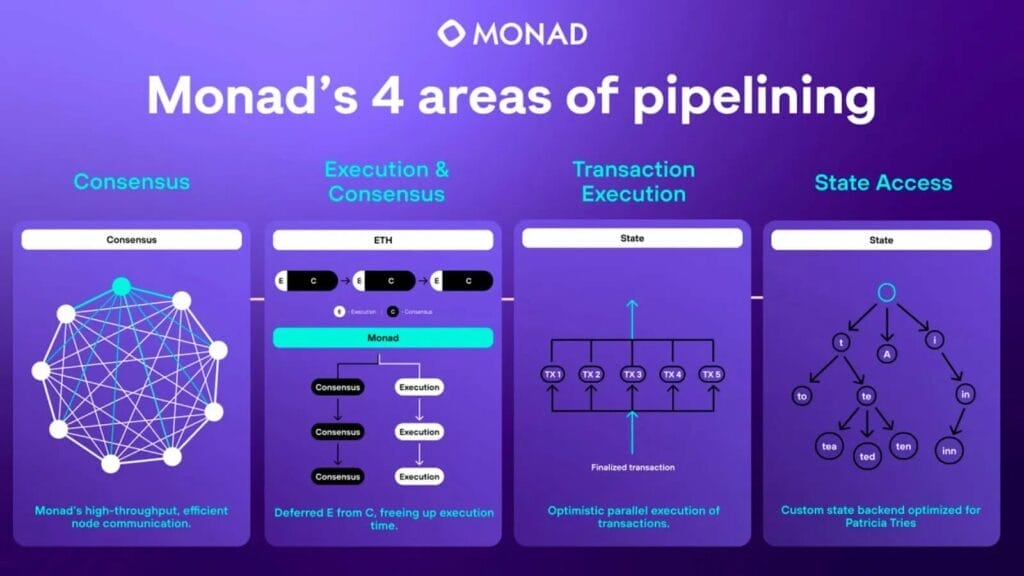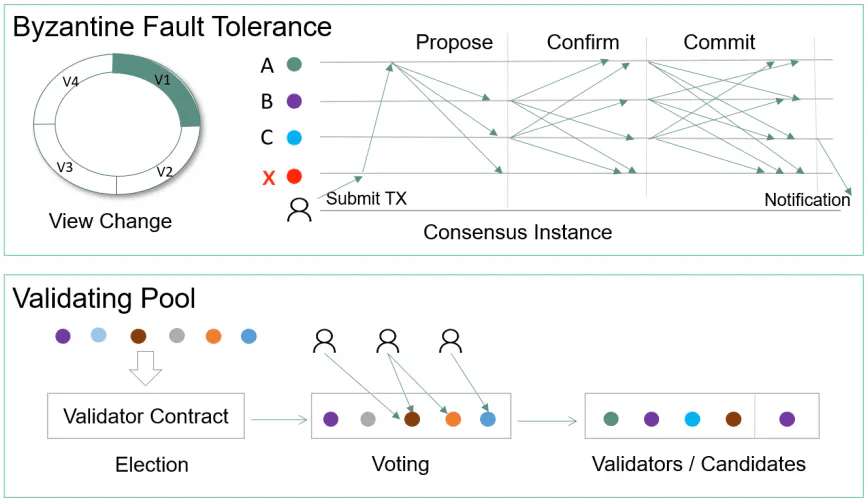In the constantly evolving landscape of blockchain technology, scalability and efficiency remain critical challenges. To address these issues, Monad Blockchain has integrated state-of-the-art mechanisms like superscalar pipelining and asynchronous I/O, each playing an essential role in maximizing the platform’s performance, transaction throughput, and overall scalability.
Discover more about: What is Monad?
Superscalar Pipelining: Enhancing Parallel Execution
1. The Basics of Superscalar Pipelining

Superscalar pipelining is a process traditionally used in computer processors to enhance throughput by allowing multiple instruction sequences to be processed simultaneously. In the context of Monad Blockchain, this technique is adapted to the blockchain’s architecture, enabling parallel processing of transactions across its network.
- Sequential Execution vs. Superscalar Execution: In conventional blockchain networks, tasks are often processed sequentially, which can limit throughput as each task must be completed before the next one begins. In contrast, superscalar pipelining in Monad enables different stages of task execution to overlap, allowing multiple instructions to be processed simultaneously.
- Parallelized Transaction Processing: Superscalar pipelining leverages Monad’s multi-core and multi-threaded architecture, where multiple cores can handle different stages of a transaction concurrently. This ensures that while one stage of a transaction is being processed, another can begin, significantly reducing latency and increasing the number of transactions processed per second (TPS).
2. Implementation in Monad’s Architecture
Monad’s integration of superscalar pipelining is not just a surface-level enhancement but a foundational component that spans several critical layers of its blockchain architecture. These layers include:
- Consensus Layer: At this level, Monad employs pipelining to streamline the agreement process among nodes, allowing multiple rounds of consensus to be processed concurrently. This reduces the time needed to reach consensus, thereby accelerating the finalization of blocks.
- Transaction Execution Phase: Monad processes the execution of transactions in a pipelined fashion, meaning that while one transaction is being executed, others are being prepared, reducing execution bottlenecks and improving throughput.
- Execution-Consensus Interface: The interface between transaction execution and consensus is designed to handle multiple transactions in parallel, ensuring that the execution layer can keep pace with the consensus layer, preventing slowdowns in block finalization.
- State Access Layer: Accessing and modifying the blockchain state is another area where pipelining is employed. This layer ensures that state changes resulting from transactions are processed efficiently, even under heavy network load, without compromising the blockchain’s consistency.
Asynchronous I/O: Maximizing Computational Efficiency
1. Understanding Asynchronous I/O
In traditional synchronous I/O operations, the CPU must wait for an I/O operation, such as reading or writing data to disk, to complete before moving on to the next task. This waiting period can lead to underutilization of the CPU, especially in blockchain environments where data access times can be unpredictable.
- Asynchronous I/O in Monad: Monad employs asynchronous I/O to eliminate these idle periods by allowing the CPU to initiate an I/O operation and continue executing other instructions in parallel. This means that while a block of data is being read from or written to disk, the CPU can perform other computations, enhancing the overall efficiency of the network.
- Impact on Transaction Processing: In Monad, asynchronous I/O ensures that transaction processing is not delayed by slow disk operations, which is critical for maintaining high throughput and low latency. The platform’s architecture allows multiple I/O operations to be handled concurrently, further boosting performance.
2. Technical Implementation in Monad
Asynchronous I/O is deeply integrated into Monad’s transaction processing and block finalization mechanisms:
- Non-blocking I/O Operations: Monad’s nodes are designed to handle I/O operations in a non-blocking manner, meaning that the blockchain can continue processing transactions and reaching consensus even as data is being accessed or stored. This prevents I/O operations from becoming a bottleneck in the network.
- Concurrency and Resource Utilization: By employing asynchronous I/O, Monad maximizes the use of its computational resources. The blockchain can manage more transactions and state changes simultaneously, leading to a more responsive and efficient network.
Pipelining in Monad’s Consensus Mechanism
1. Byzantine Fault Tolerant (BFT) Consensus

Monad’s consensus mechanism is a Byzantine Fault Tolerant (BFT) model, specifically a variant of the HotStuff consensus algorithm. This model is designed to achieve agreement among nodes under partially synchronous conditions, even in the presence of Byzantine actors—nodes that may behave maliciously or unpredictably.
- Two-Phase Consensus Process: The consensus process in Monad is executed in two phases. The first phase involves the leader node broadcasting a new block proposal along with a quorum certificate (QC) or a timeout certificate (TC) from the previous round. Validators then assess the validity of the block and send their signed YES votes to the leader of the next round.
- Pipelined Consensus Execution: In this system, superscalar pipelining is employed to allow different phases of consensus to overlap. For instance, while one phase of consensus is being executed, preparations for the next phase can begin, reducing the time required to reach consensus and improving block finalization speed.
2. Handling Network Delays and Malicious Actors
- Timeout Mechanism: If a block is not received within a specified timeframe, validators broadcast a signed timeout message, including the most recent QC they have observed. These timeout messages are aggregated into a TC, which is then forwarded to the next round’s leader. This ensures that consensus can proceed even in the event of delays or malicious interference.
- Mitigating the Impact of Byzantine Actors: The pipelined consensus process in Monad is resilient to Byzantine faults, ensuring that even if some validators behave unpredictably, the network can still reach agreement on the state of the blockchain.
Deferred Execution for Enhanced Scalability
1. The Challenge of Synchronous Execution
In many blockchain systems, execution is tightly coupled with consensus, meaning that transactions must be executed before they can be included in a block. This synchronous approach can limit scalability, as the time required to execute transactions can create bottlenecks in the consensus process.
2. Monad’s Deferred Execution Model
Monad introduces a deferred execution model, which decouples the execution of transactions from the consensus process:
- Decoupling Execution from Consensus: In Monad, the consensus process focuses solely on agreeing on the order of transactions, not their immediate execution. This allows the blockchain to reach consensus more quickly, as the heavy computational work of transaction execution can be deferred to a later stage.
- Parallel Processing of Transactions: Once consensus on transaction order is achieved, transactions can be executed in parallel, further enhancing scalability. This approach allows Monad to handle a higher volume of transactions without compromising the speed or security of the consensus process.
Shared Mempool and Transaction Efficiency
1. Optimizing Pending Transaction Handling
Monad’s shared mempool system is designed to manage pending transactions efficiently before they are finalized in a block:
- Independent Validator Mempools: Each validator maintains its own mempool, where pending transactions are stored. These transactions are shared among validators using erasure coding and broadcast over a communication tree, ensuring that all validators have access to the necessary transaction data.
- Reducing Block Propagation Bottlenecks: Large blocks, especially those containing thousands of transactions, can strain network bandwidth during propagation. Monad addresses this by referencing transactions through their hashes, which are smaller in size and easier to transmit, conserving bandwidth and speeding up block propagation.
2. Efficiency in High-Traffic Scenarios
- Bandwidth Conservation: By referencing transactions by hash rather than including full transaction data in every block, Monad reduces the amount of data that needs to be transmitted across the network. This conserves bandwidth and ensures that the consensus process remains efficient, even when transaction volumes are high.
Carriage Cost and Reserve Balance: Safeguarding Network Integrity
1. Preventing Denial-of-Service (DoS) Attacks
To prevent malicious actors from overwhelming the network with spam transactions, Monad introduces the concepts of carriage cost and reserve balance:
- Carriage Cost: This is a fee associated with sending a transaction across the network and including it in a block. The carriage cost is deducted from the sender’s reserve balance, ensuring that only transactions that are paid for are included in blocks.
- Reserve Balance: Each account on Monad maintains a reserve balance, separate from its execution balance. The reserve balance is used to cover carriage costs, while the execution balance covers the costs associated with executing the transaction itself.
2. Ensuring Orderly Transaction Processing
- Dual-Balance System: The dual-balance system ensures that even during periods of high network activity, transactions are processed in an orderly manner. Only transactions with sufficient funds to cover both carriage and execution costs are included in blocks, preventing spam attacks and ensuring the integrity of the network.
Conclusion
Monad’s integration of superscalar pipelining and asynchronous I/O represents a significant leap forward in blockchain technology. These innovations enable the platform to process transactions with unprecedented speed and efficiency, making it one of the most scalable and robust blockchain networks to date. By optimizing parallel execution, decoupling execution from consensus, and ensuring that I/O operations do not hinder computational processes, Monad sets a new standard for what is possible in decentralized networks. As the blockchain industry continues to push the boundaries of scalability and performance, Monad’s approach serves as a blueprint for the future of decentralized, highly efficient, and scalable blockchain systems.
About OriginStake
Originstake is your professional and trusted validator that assists you in your staking activities. We provide full support services, a reward management dashboard, rewards sharing, and much more!
With Originstake, staking is safe, profitable, and extremely cost-effective!





